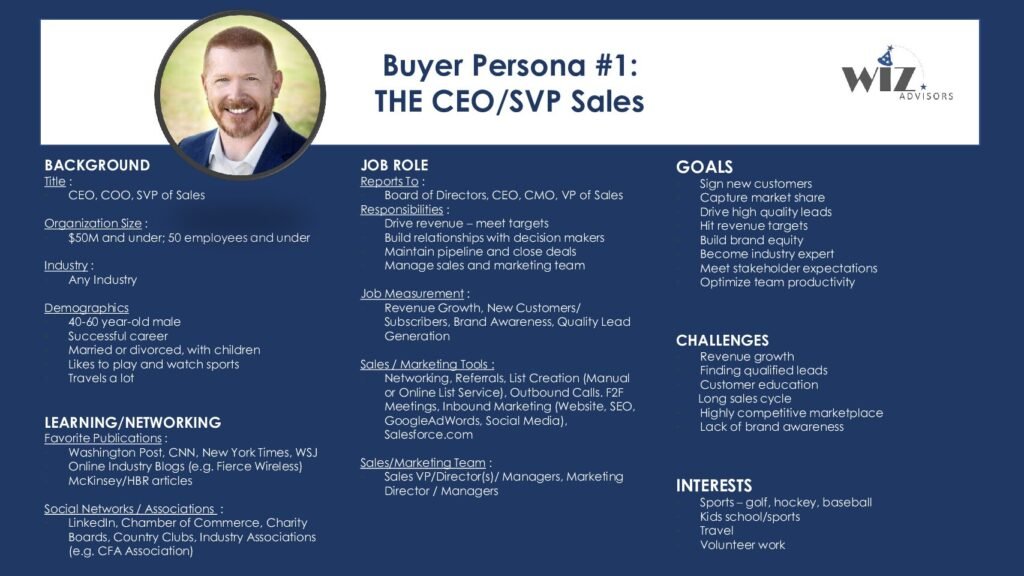- April 5, 2021
- Posted by: Stacey Wisniewski
- Category: Marketing Strategy

A foundational element of successful B2B marketing that isn’t new but has been gaining more attention lately is the concept of Customer Persona(s). With the move to digital-first marketing over the past year, competition for your prospects’ attention has grown exponentially. If you aren’t 100% sure who you want to target, what their pain points are, how your solution can help them, and where to find them – your message will get lost in the shuffle.
Has anyone ever walked you through exactly what goes into a Customer Persona – or Ideal Customer Profile (ICP) – and how to build one? Do you know how to use it once it’s built? You’re not alone. In this article, we will answer the most common questions we receive:
- What is a Customer Persona – or ICP?
- Why is it so important?
- How do I create one?
- How do I make it actionable?
What is a Customer Persona and why is it SO important?
A Customer Persona (ICP) is a snapshot of your ideal customer. While it is not created based on an actual person, the information that goes into it is based on the customers you already have – or would like to target. It includes all the information you would gather when building a relationship with a sales prospect.
Customer Personas are extremely important because they allow your Sales and Marketing teams to align on who they are targeting, why and how. Based on this persona, they can tailor their messaging, ad campaigns, sales emails and content to address your ideal customers’ specific needs and concerns. You can – and should – have multiple ICPs according to how you segment your customer base. For example, you may have three different solutions for three different industries – and each industry should have its own ICP.
A Customer Persona that few people talk about – or even know exists – is a Negative Persona. Similar to negative keywords in a Google AdWords campaign, you create a Negative Persona in order to exclude a particular type of customer from your target list. Two of the most common types of negative personas are: a) customers who are too early stage or advanced, and b) customers who are too expensive (negative ROI) to acquire.
How do I create a Customer Persona?
Creating a Customer Persona is not difficult if you have a good template (and you are in luck, because we provide two examples of our WIZ Advisors template below!). The basis of your Customer Personas should come from market research and/or a deep dive into your current customer base.
Below is a list of the data points that are typically included.
- Demographics – age range, gender, geography, education level, marital status, household income
- Position and Level of Seniority – their title, where they fall in their company’s hierarchy and their purchasing power
- Identifiers and Day-in-the-life – what does their typical day look like and how would your product or service fit, demeanor, preferences about how they receive content
- Main source for research / education – internet search, professional publications, social media, online communities
- Pain Points and how you can help solve them – do they know they need what you have to offer yet? How do you convince them? Why are they dissatisfied with their current product or service?
- What are their goals – obtaining lower price, faster go-to-market solution, greater competitive advantage
- What common objections might they voice about your product or service? – price, delivery speed, already have something I’m fine with
- Quotes from your current prospects/customers about goals, challenges, etc.
Here are two Customer Personas (ICPs) we created at WIZ Advisors for our target customers.


How do I make a Customer Persona actionable?
You’re likely thinking, “OK, great – I’ve created my Customer Persona – now how do I use it? As we mentioned in the introduction, you are creating these ICPs to align your sales and marketing teams towards gaining your prospects’ now VERY limited attention.
Once you have your ICPs built, you can start creating targeted advertising, content and sales emails that address your ICP’s specific pain points.
Your prospects will say, “wow, these guys really understand me.” They will trust you more right off the bat, because you have taken the time to know who they are and what they really need.
You can also use your Customer Personas in conjunction with your Buyer’s Lifecycle Stages to create highly targeted content at each lifecycle stage – and reach the right customer at the right time.
(If you haven’t seen our Content Across the Buyer’s Lifecycle Infographic, click here to download. It provides great examples of the various types of content that you can use for each lifecycle stage.) By creating a portfolio of content based on your ICPs, you will create a smooth path to purchase and shorten the sales cycle.
And lastly, your ICPs will tell you where your prospects go to learn, get educated and network. You will use those locations to target your advertising or write content for publication in order to reach the audience you want.
We hope this article has provided you with the knowledge and tools to create personas for your own business.
Please reach out to us anytime with questions as you build them. We look forward to hearing from you!